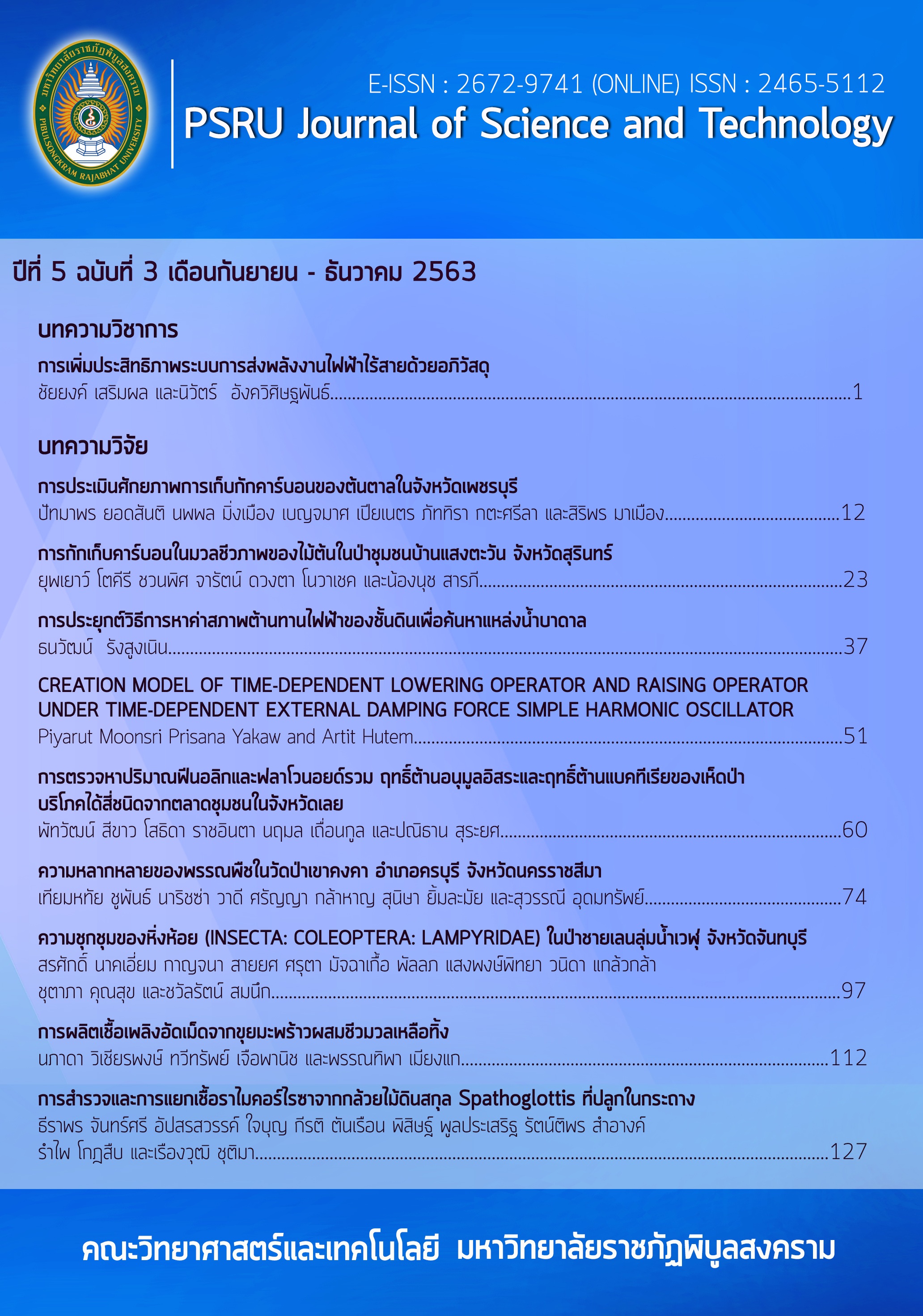APPLICATION OF THE ELECTRICAL RESISTIVITY DETERMINATION OF GROUND LAYER FOR THE GROUNDWATER SOURCES PREDICTION
Keywords:
Electrical resistivity, Groundwater sources, Exploration geophysicsAbstract
The research on application of the electrical resistivity determination of ground layer for the groundwater sources prediction was conducted to survey, and assesses the potential of the exploration points on developing groundwater sources for the community. A geophysical exploration via electrical resistivity method was employed to measure and analyze the soil layers at the survey points at Sokchan Pattana village, Makluea Kao subdistrict, Sung Noen district, Nakhon Ratchasima Province. Experimental survey data were compared to the data of the groundwater wells at the nearby area. For the physical aspect, the result was shown that the data at the survey area of 7 points were aquifers that consistent with the geological data set of rocks Khok Kruat Formation. Geophysics aspect via exploration of a vertical electrical resistivity method, there were 2 points that seem to have potential of development for groundwater wells as: points A1 and A3. They could have groundwater at the depths of 34.65 and 39.74 meters, respectively. Whereas, the survey point A5 was likely to find groundwater at the depth of 62.5 meters. It can be concluded that the surveyed areas have opportunity and trend to find groundwater in aquifers of Khok Kruat Formation. The amount of water was at 2-20 cubic meters per hour at the depths between 30 and 90 meters with a good quality of water.
References
การประปาส่วนภูมิภาค. (2554). การสำรวจน้ำบาดาลด้วยวิธีวัดความต้านทานไฟฟ้าจำเพาะ. กรุงเทพฯ: การประปาส่วนภูมิภาค.
กิตติชัย วัฒนานิกร. (2526). การสำรวจธรณีฟิสิกส์สำหรับนักธรณีวิทยาและวิศวกร. เชียงใหม่: ภาควิชาฟิสิกส์ คณะวิทยาศาสตร์ มหาวิทยาลัยเชียงใหม่.
กรมทรัพยากรน้ำบาดาล. (2551). โครงการสำรวจธรณีฟิสิกส์หมู่บ้านภัยแล้งทั่วประเทศ. กรุงเทพฯ: เอทอป เทคโนโลยี.
กรมทรัพยากรธรณี. (2553). การจำแนกเขตเพื่อการจัดการด้านธรณีวิทยาและทรัพยากรธรณีจังหวัดนครราชสีมา. กรุงเทพฯ: จันวาณิชย์ซีเคียวริตี้พริ้นติ้ง.
กรมทรัพยากรธรณี. (2554). ลำดับชั้นหินของกลุ่มหินโคราช บริเวณขอบตะวันตกของที่ราบสูงโคราช. กรุงเทพฯ: กรมทรัพยากรธรณี.
ดนุพล ตันนโยภาส และคณะ. (2553). การสำรวจความต้านทานไฟฟ้าธรณีในพื้นที่มหาวิทยาลัยสงขลานครินทร์วิทยาเขตหาดใหญ่. ในการประชุมวิชาการทางวิศวกรรมศาสตร์ มหาวิทยาลัยสงขลานครินทร์ ครั้งที่ 8 (น. 870 – 875). สงขลา: มหาวิทยาลัยสงขลานครินทร์.
ทองเปลว กองจันทร์. (2562). ปรากฏการณ์เอลนีโญและลานีนาในประเทศไทย. สืบค้นเมื่อ 21 ตุลาคม 2562, จาก http://kmcenter.rid.go.th/kchydhome/km_hydro/article&id=1.php
ปรียาพร โกษา. (2555). การประเมินศักยภาพแหล่งน้ำผิวดินและแหล่งน้ำบาดาลเพื่อการผลิตประปาชุมชน. นครราชสีมา: มหาวิทยาลัยเทคโนโลยีสุรนารี.
ปรเมศร์ อมาตยกุล, และเทวินทร์ โจมทา. (2557). อุตุนิยมวิทยาน่ารู้เพื่อการเกษตรจังหวัดนครราชสีมา.กรุงเทพฯ: กรมอุตุนิยมวิทยา.
เพียงตา สาตรักษ์, อภิชาต บุตรพิเศษ, ประดิษฐ์ นูแล, และถนัด สร้อยซา. (2545). การตรวจหาโพรงและชั้นเกลือหินใต้ผิวดินด้วยวิธีวัดความต้านทานไฟฟ้าจำเพาะ. วารสารวิจัย มข., 7(2), 22-32.
เพียงตา สาตรารักษ์, วินิจ ยังมี และสุวิจักขณ์ มีสวัสดิ์. (2549). ค่าความต้านทานไฟฟ้าจำเพาะจริงของชั้นนำบาดาลเค็ม และโพรงใต้ผิวดินในพื้นที่ภาคตะวันออกเฉียงเหนือ. วารสารวิจัย มข., 11(1), 4-16.
เพียงตา สาตรักษ์, และสาคร แสงชมภู. (2554). การประยุกต์สำรวจวัดสภาพต้านทานไฟฟ้าแบบ 2 มิติ เพื่อตรวจลักษณะภายในทำนบดินของอ่างเก็บน้ำเพื่อชลประทาน. ขอนแก่น: ภาควิชาเทคโนโลยีธรณี คณะเทคโนโลยี มหาวิทยาลัยขอนแก่น.
มหาวิทยาลัยเกษตรศาสตร์. (2562). ทรัพยากรน้ำ. สืบค้นเมื่อ 21 ตุลาคม 2562, จาก https://web.ku.ac.th/schoolnet/snet6/envi2/subwater/subwater.htm
ศุภกร กตาธิการกุล, ภรพนา บัวเพชร์, และฉัตร ผลนาค. (2549). การศึกษาขอบเขตน้ำพุร้อน อำเภอนบพิตำ จังหวัดนครศรีธรรมราช โดยระเบียบวิธีการตรวจสภาพต้านทานไฟฟ้าทางแนวดิ่ง. วารสารวิทยาศาสตร์ทักษิณ, 3(2), 54-66.
สมยศ วิชชุวลัญช์. (2538). รายงานการสำรวจชั้นน้ำใต้ดินด้วยวิธีวัดสภาพต้านทานทางไฟฟ้า ณ พื้นที่โครงการบริษัท หาดทิพย์ จำกัด ตำบลกำแพงเพชร อำเภอรัตภูมิ จังหวัดสงขลา. สงขลา: มหาวิทยาลัยสงขลานครินทร์.
อัฆพรรค์ วรรณโกมล. (2555). การทำแผนที่น้ำบาดาลด้วยวิธีการสำรวจทางไฟฟ้าในบริเวณพื้นที่จังหวัดนครราชสีมา (รายงานการวิจัย). นครราชสีมา: มหาวิทยาลัยเทคโนโลยีสุรนารี.
Bian H., Liu S., Chu Y., & Cai G. (2019). Estimation of Oil-Contaminated Soils’ Mechanical Characteristics Using Electrical Resistivity. In Zhan L., Chen Y., & Bouazza A. (Eds), Proceedings of the 8th International Congress on Environmental Geotechnics Volume 1 (pp. 645-652). Singapore: Springer.
Nwankwo, L.I., Olasehinde, P.I. & Osundele,O.E. (2013). Application of electrical resistivity survey for groundwater investigation in a Basement rock region: A case study of Akobo – Ibadan, Nigeria. Ethiopian Journal of Environmental Stydies and Management, 6(2), 124–134.
Yoon, G.L. & Park, J.B. (2001). Sensitivity of Leachate and Fine Contents on Electrical Resistivity Variations of Sandy soils. Journal of Hazardous Materials, 84(2-3), 147–161.
Victor O. Umeh, Chukwudi C. Ezeh & Austin C. Okpnkwo. (2014). Groundwater Exploration of Lokpaukwu, Abia State Southeastern Nigeria, Using Electrical Resistivity Method. International Research Journal of Geology and Mining (IRJGM), 4(3), 76–83.
Downloads
Published
How to Cite
Issue
Section
License
กองบรรณาธิการขอสงวนสิทธิ์ในการปรับปรุงแก้ไขตัวอักษรและคำสะกดต่างๆ ที่ไม่ถูกต้อง และต้นฉบับที่ได้รับการตีพิมพ์ในวารสาร PSRU Journal of Science and Technology ถือเป็นกรรมสิทธิ์ของคณะวิทยาศาสตร์และเทคโนโลยี มหาวิทยาลัยราชภัฏพิบูลสงคราม และ
ผลการพิจารณาคัดเลือกบทความตีพิมพ์ในวารสารให้ถือมติของกองบรรณาธิการเป็นที่สิ้นสุด







